April 3, 2015 – We leave this morning on our northward journey with one more night in Baja Californian Sur. We will be heading for Guerrero Negro and Mario’s RV Park and the forecast is for cooler temperatures, we will see.
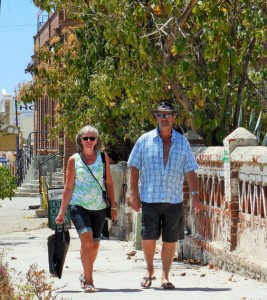
Pescadero – After leaving Cabo San Lucas our next stop was the Los Cerritos Surf Colony, but first we needed to get out of Cao San Lucas. Shortly after leaving the RV Park and heading for Hwy 19 we ran into a detour, unfortunately without much signage to get us to back on track. I did my best guess and then we had a Taxi driver telling us to follow him, we did and it all turned out well, back on track. We did stop at the Blanket Factory, a visit we always look forward to, Afrain was ready for us with the freshly made buns right out of his beehive oven. The gang enjoyed the stop and Afrain certainly appreciated the business and meeting “Mama Sylvia” again.

Next stop and our destination was the Los Cerritos Surf Colony and folks were ready to get settled in and hit both the pool and the beach. John, Morag and Val were keen to try the Boogey Board and the waves were breaking well on the surf. Everyone else were headed poolside, in the pool or hot tub, or all three. Also some walking on the beach and up to the Boutique Hotel on the point. A great afternoon for sure and a good way to build an appetite for La Pasadita. Just after 5 pm we were off to Pescadero and La Papadita, a very authentic Mexican Roadside eatery. Again a road was closed and we were inti the dirt, just adding more adventure to a good meal. Jose and family did a great job as always, everyone had lots to eat and thoroughly enjoyed the experience. On our return to Los Cerritos, some headed to the pool other just sat out and enjoyed the warm pacific breeze.

La Paz – The next day a late start for everyone as Todos Santos really did wake up until 10 AM. Lots of celebrations around during Easter week and we came across a Caballeros at the entrance to Todos Santos. After getting everyone parked the gang set out in many different directions around town which always includes the famous Hotel California made so by the legendary band The Eagles. Good thing we did not take the main drive, it was all tore up and under rebuild as well (underground power supply I understand). We had brunch with Mark, Katherine and Sylvia and yes the Hotel California were in, but not the Tequilla Sunrise calcomanies. After lunch we headed for our destination, Campestra Maranatha just north of La Paz. It was going to get hotter and we knew this, after our short stop at Walmart, we arrived at the RV Park and it was 38.8 C or 101 F. Good that the pool was open, we needed to cool down.
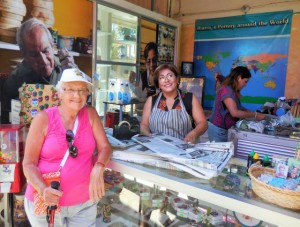
Sunday we headed for the Malecon walkabout, and Bill, Bev, John, Morag and Val caught a boat to swim with the Wale Sharks who were in the bay. Other checked out the lower town and we went to our favourite Hamburger & Hot Dog Stand for lunch. Later most of the gang joined us for dinner at Los Magueyes, again very authentic Mexican menu but very different to La Pasadita. The meal did not disappoint, neither did the flaming flan! Monday and most headed off to Ibarra’s Pottery, Johnny, John, and Tim had a 7 am fishing trip planned. After seeing Vicky and her Mom we were off to the market and walkabout in town, lots were astonished when they cheked out the Yeneke Hotel, words just cannot express the décor.

Puerto Escondido – 8 am on Tuesday and we continued our northward journey, today’s destination the Fonatour Marina at Puerto Escondido. No trouble getting parking now as they have a fee schedule set for RVs and we had made reservations for dinner, unfortunately with confusion. We had attempted to make reservations at the new waterfront restaurant, they ended up being at the Tripui Hotel, and eventually we did sort this out, with folks eating at both. The meal at the new place was expensive but very tasty, not sure they have the clientele to support the fine dining in the future, we will see next season. Interesting enough I had a hot shower, while other did not, really not sure why? The sunrise was beautiful the next day, unimpeded by any cloud cover, the mountains were as red as they can be, breathtaking for sure.

Mulege – April 1st and were off to Mulege, Mama Sylvia reminded me that had her husband Ken still been alive they would have been celebrating 65 years of marriage (Ken passed away in 1979 and Sylvia never remarried). We had only left our overnight stay and we stooped at the new Juncalito overlook, the only one on Hwy 1 south of Ensenada that I know of, what a view! A few photos and we were off again, next stop the Military Checkpoint north of Loreto. The lads asked Lisa’s Mom her name, she said Sylvia, and they said “Mama Sylvia”, which has now stuck. The beaches were busy for Easter with Mexican vacationers, good time not to be on the beach with your RV. When we arrived at the Hotel Sererindad, we had couple of vehicles in our reserved spots which we did sort out, and it was still hot, over 34 C, 90 plus F.

Our excursion for the afternoon dropped off the laundry, then off to the Heroic Mulege Lighthouse, Loma Linda Hotel (no access because of water main construction), the Prison Museum and the Santa Rosalia Mission and overlook. What was very interesting and surprising was the new road being built out the lighthouse given how damaged the newly installed Malecon was after Odile, wonders never cease in Mexico. We also dropped by the Orchard, which we have friends residing at and has been damaged by 4 hurricanes. This used to be an RV Park, not sure how many more floods this place can take. Later everyone was in the pool to beat the heat. At the same time some enjoyed Romans’s bar service, some had lunch and we later had dinner which was Todo Bien. Day 2 in Mulege and we made a few trips with folks into pick up laundry, bank, others to shop and look around. Poolside was in everyone’s future in the afternoon as the temperatures continued to rise.
One more day in Baja California Sur and we finally may see some cooler temperatures.

Did you know?
Baja California Sur, “Lower California South”, officially Free and Sovereign State of Baja California Sur (Spanish: Estado Libre y Soberano de Baja California Sur), is the second smallest Mexican state by population and the 31st admitted state of the 31 states which, with the Federal District, make up the 32 Federal Entities of Mexico. Before becoming a state on October 8, 1974, the area was known as the South Territory of Baja California (El Territorio Sur de Baja California). Located in northwest Mexico, it has an area of 73,475 km2 (28,369 sq mi), or 3.57% of the land mass of Mexico, and occupies the southern half of the Baja California peninsula, south of the 28th parallel, plus the uninhabited Rocas Alijos Island in the Pacific Ocean. Baja Sur is approximately about 750 km (480 miles) long and averages about 100 km (60 miles) wide. It is bordered to the north by the state of Baja California, to the west by the Pacific Ocean, and to the east by the Gulf of California, also known as the “Sea of Cortés”. The state has maritime borders with Sonora and Sinaloa to the east, across the Gulf of California. The state is home to the tourist resorts of Cabo San Lucas and San José del Cabo. Its largest city and capital is La Paz.

The state is divided into five municipalities. Comondú is located in the center of the state with its seat at Ciudad Constitución. It borders the municipalities of Mulegé, Loreto and La Paz with the Pacific Ocean to the west. Mulegé is in the north of the state with its capital in Santa Rosalía, with two other important population centers at Guerrero Negro and Mulegé. It borders the municipalities of Comondú and Loreto with Baja California Norte to the north, the Pacific Ocean to the west and the Gulf of California to the east. It accounts for almost 45% of the state’s territory. The municipality of La Paz is in the south of the state. It is the second largest municipality, accounting for just over 27% of the territory of the state. It borders the municipalities of Comondú and Los Cabos and extends from the Pacific Ocean to the Gulf of California. The municipality of Los Cabos is at the southern tip of the state, with its seat at San José del Cabo and its most populous city is Cabo San Lucas. The municipality is one of the most important tourist destinations in Mexico. The municipality borders that of La Paz to the north, with the rest defined by the Pacific Ocean and Gulf of California. The municipality of Loreto is located in the center of the state, with the city of Loreto as its seat. It borders the municipalities of Mulegé and Comondú with the Gulf of California to the east. Its major cities are La Paz (219,596) San Jose del Cabo (164,162) Ciudad Constitución (63,830) Santa Rosalia (52,743) Loreto (11,839). Other important cities include: Ciudad Insurgentes, Comondú Municipality, Guerrero Negro, Mulegé Municipality, Loreto, Loreto Municipality, El Pescadero, La Paz Municipality and Todos Santos, La Paz Municipality.

Geography & Ecology
The state is on a narrow peninsula which broke away from the mainland about two million years ago because of tectonic activity. The territory is primarily mountains or mountain ranges and coastal plains. The mountain ranges parallel the coastline and are of volcanic rock with an average altitude of 600 meters above sea level. The local name for the main mountain range is the Sierra de la Gigante and the highest peak is the Sierra de la Laguna at 2080 meters above sea level. The coastal plains are significantly wider on the Pacific side than the Gulf of California side, with those on the Pacific side averaging a width of about forty, with much wider plains such as those of Santa Clara, Berrendo and Magdalena y Hiray. These areas are dominated by sedimentary rock, especially limestone of marine origin.

The state is divided into five regions: Central Desert, La Serranía, the Vizcaíno Desert, the Magdalena Plains and Los Cabos. The Central Desert has desert plants and the only green appears during short and irregular rains. The La Serranía is the high mountain areas with tree species, a number of which are commercially valuable. The Vizcaíno Desert runs along the Pacific coast around the Ojo de Liebre and San Ignacio lagoons and contains lower mountain ranges such as the San Francisco, San Alberto, Las Tinajas de Murillo and El Serrucho, along with the El Azufre and Las Vírgenes volcanos. The Magdalena Plains is a large, flat area near the Pacific coast, and the Los Cabos region is distinguished by microclimates determined by the geologic change in the area and rain patterns.

The climate of the state is dry, with an average annual temperature between 18 and 22C and average annual rainfall of less than 200mm. The lower elevations are the driest and hottest, with temperatures climbing as high as over 40C in the summer. The winters can see lows of below freezing. The exception to desert conditions is the Los Cabos region, classified as semi-moist because of Pacific hurricane activity affects the region. In the spring, prevailing winds are from the west and in the summer from the south and southwest. In the fall, they are from the northwest and in the winter from the north and northwest. Most of the surface water on land is in the form of seasonal streams, which are fast flowing and only active during rains. Most of these empty into the Pacific Ocean with a number flowing south into the Bahía de Ballenas.

The main geological feature of the state is its coastline which measures 2230 km, (1300 miles) making it Mexico’s longest with 22% of the total. It also has the most islands, mostly in the Gulf of California. There are three in the Pacific, Natividad, Magdalena and Santa Margarita (the largest). In the Gulf of California they include San Marcos, Coronasos, Carmen, Monserrat, Santa Catalina, Santa Cruz, San Diego, San Jose, San Francisco, Partida, Espiritu Santo and Cerralvo. Major bays include Sebastian Vizcaino, Magdalena, La Paz, Asunción, Ballenas, Concepcion and San Carlos. Estuaries and lagoons including those at Puerto Escondido, Nopoló, Blandra as well as the San José estuary at Cabo Colorado, the San Ignacio Lagoon and the Ojo de Liebre.

The ecological system here is considered to be recently evolved with a number of endemic species. The lower elevations are dominated by desert and arid condition plants. This includes the world’s largest species of cactus, the cardón cactus, which can reach heights of 21 meters. Other plant species include mesquite, chironola, lechuguilla, nopal and barrel cactus, choyas, paloadan and pitahaya. The higher elevations have forests of pine and holm oak with some deciduous forests, with leaves falling in the dry season, generally no taller than fifteen meters. Wildlife in the desert areas is restricted to birds, reptiles and small to medium mammals such as rabbits and coyotes. Upper elevations with more vegetation can have wild rams, pumas, other wild cats, raccoons, deer, foxes and wild cats. Marine species include whales, seals, dolphins, gray whales, manta rays and sea turtles. National parks and other protected areas include the Sebastian Vizcaino Bay, the San Ignacio Lagoon, the Sierra la Laguna, Laguna Ojo de Liebre and the islands in the Gulf of California.

Early History
Baja California Sur was inhabited as early as 11000 B.C. Nomadic tribes left behind artifacts such as arrow heads and Clovis points, which have been discovered in the northern part of the state. Cave paintings in the Sierra de San Francisco are evidence of early human habitation is found in primitive rock and cave paintings dating to 1700 BCE, created by hunting and gathering societies that lived in rock shelters. The state is one of five areas in the world with important concentrations of cave paintings. These painting have an identifiable style and tend to be on a monumental scale with some figures as tall as four meters. Most of the animals are painting in silhouette and depicted in movement, often being hunted by people. The best known site is the Great Mural Rock Art which dates from 1700 BCE, located in the north of the state. Other important sites include Cueva de Palma, San Gregorio, Santa Teresa, Guadalupe, San Francisco, Cabo Pulmo, Santiago and San Borjita. The most important concentrations are in twelve km 2 zone in the north of the state, centered on the Sierra de San Francisco. In sites near Comondú, Las Palmas and Cocheros, there are also arrowheads, utensils and petroglyphs. Las Palmas contains secondary burials of human bones painted with red ochre. When the Spanish arrived, these peoples were long gone and there were four main ethnic groups: the Pericúes in the south between Cabo San Lucas and La Paz, the Guaycuras in the area north of the Pericú to Loreto, the Monquils near Loreto and Cochimí in the middle of the peninsula. All were hunter/gatherers without agriculture or metal working but produced pottery. They also fished, but only the Pericúes had rafts.

Colonial Times
The first Spaniard in the area is believed to be Fortún Ximénez, arriving in 1533. He and his crew did not remain long because they sacked the area’s pearls and abused the women, prompting a violent confrontation with the natives, who killed Ximénez. The remaining crew returned to Mexico City with the pearls and stories of riches. A year later in 1535, Hernán Cortés navigated into the Gulf of California, which he called the Sea of Cortés. He landed in what is now the bay of La Paz, which he named the Santa Cruz Port and Valley. This event is celebrated in La Paz as its founding. However, he did not remain.
Despite various explorations, the remoteness of the region impeded efforts at colonization until the 17th century, with in 1697, Jesuit missionary Juan María de Salvatierra established the Nuestra Señora de Loreto Conchó Mission, the first permanent one of its kind in Baja California Sur. From there the order spread through most of the current state, founding sixteen mission in territory of the current state to work with the Pericú, Guaycura and Cochimí peoples. During the 18th century, more colonists arrived bringing diseases that caused a significant decrease in the indigenous population. In 1768, the Jesuits were expelled from New Spain and the Franciscans took over the missions, continuing the expansion north. In 1773 they were replaced by the Dominicans. A number of these mission churches still survive. The important ones include the Loreto Mission, the La Paz Cathedral, the San José del Cabo Mission and the San Javier Mission.

19th Century
During the 19th century, the influence of the missions waned with most closing in the early part of the century. However, many of the mission facilities became the centers for ranching operations and some agriculture. Without the protection of the monks, and the lack of governmental control, the indigenous peoples of this time were commonly abused by the ranchers. In the early 19th century, Baja California was divided into four municipalities, Loreto, San José del Cabo, San PeroMartir and Santa Gertrudis.

The southern peninsula’s isolation kept it out of the fighting during the Mexican War of Independence. Although this war ended in 1821, the remoteness of the area allowed the Spanish to maintain control of the southern peninsula until 1822. Afterwards, it was divided into four municipalities by Guadalupe Victoria and Governor José María Echendía. Loreto was the original capital of the peninsula until 1830, when destruction of the town by heavy rains forced the government’s relocation to La Paz, which has been the capital since.

The United States invaded the peninsula during the Mexican-American War and wanted it as part of the Treaty of Guadalupe Hidalgo, but the Mexican government succeeded in keeping control of the territory. In 1853, William Walker and 45 other American captured the city of La Paz. However, they did not have official U.S. support and were quickly driven out again by Mexican forces. During the Reform War, Liberal forces under General Manuel Marquez de Leon and others captured La Paz. French forces then invaded the country to support the Conservative cause and then Governor Felix Gilbert recognized Emperor Maximilian. However, Mexican forces under Benito Juarez forced the French out, with Coronel Clodomiro Cota, recapturing the peninsula from the French. The division of the peninsula into north and south occurred in 1888 by the federal government under Porfirio Diaz .
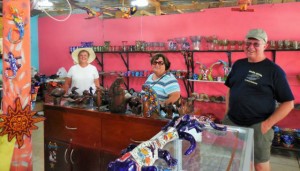
20th Century until today
During the regime of Porfirio Diaz (1876 to 1910), the Mexican government invited foreign enterprises to enter the country to develop it. In Baja California, these included mining operations including a major French mina called El Boleo (today Santa Rosalia) and the establishment of maritime routes. This president also divided the peninsula into two parts, each with its own government. The southern peninsula was not involved in the Mexican Revolution until after the assassination of Francisco I. Madero, when troops were organized in opposition to Victoriano Huerta, his successor under Félix Ortega. These troops defeated federal troops in 1914 and took over La Paz.

From the end of the Mexican Revolution to 1974, the territory had ten governors appointed by the federal government. The division of the peninsula was further formalized in 1931, with a highway extending its length the same year. Infrastructure remained a priority for the area, with the establishment of schools including the first teachers’ college in 1942, as well as projects to provide water and electricity. The southern territory became a state on October 8, 1974, with three municipalities: La Paz. Comondú and Mulegé. Two others have been carved out since then, Los Cabos in 1981 and Loreto in 1992.

Industry & Economics
Traditionally based mostly on tourism, sport fishing, salt production and mining, in 2012 the GDP of the state accounted for only .73% of the country’s GDP, but grew 3.13% in comparison to the year prior. In 2013, this growth increased to 7.8%. Unemployment in 2013 was 5.1% with employment shifting away from agriculture and fishing to mining and industry (up 19.9%) and commerce (up 4.9%). Today, agriculture, fishing and forestry account for only 3.89% of the state GDP. Commercial species include tuna, sardines, anchovies, clams, snails, oysters, shark, lobsters, abalone, shrimp and crabs, which are sold both nationally and internationally. Commercial fishing harvests lobster, shrimp, tuna, abalone and clams. Major crops include garbanzo beans, sorghum, tomatoes, alfalfa, wheat, corn and green chili peppers. Livestock includes pigs, cattle, goats and chickens.
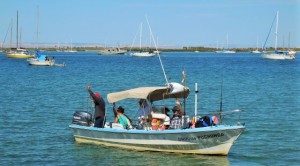
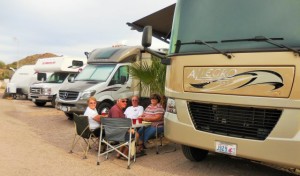
Mining, construction and utilities account for 26.61%. Mining includes plaster (mainly on the San Marcos Island), limestone (in Todos los Santos), phosphorus (in San Juan de La Costa and Adolfo López Mateos, Comondú), copper (en Santa Rosalía), gold and silver (in the Triunfo-San Antonio mine), manganese (in Santa Rosalia and Punta Concepción Bay) and chrome (in San SebastiánVizcaíno and Magdalena bays). There are other minerals not yet routinely mined such as titanium, tungsten and cobalt. There is some possibility of offshore hydrocarbons. The state also produces salt of 99.7% purity, mostly in the area around Guerrero Negro. There are two major industrial/technology parks: Parque Tecnológico BioHelis and Parque Industrial La Paz Sur. Traditional handcrafts can be found throughout the state and include articles made with seashells, palo chino, choya and cardon cactus. Baskets and other items are woven from palm fronds especially in el Triunfo Los Planes and the Sierra de los Dolores as well as fishing nets. Another important craft is leatherwork, especially the making of gear for horseback riding such as saddles, holsters and chaps along with belts and carrying bags. In addition, scrap metal is converted into various types of knives.

Commerce and services account for 69.5% of the GDP in Baja Sur. La Paz was ranked 31st in Mexico by the World Bank and the Corporación Financiera Internacional in ease of doing business and 23rd as a place to open a business. Major activities of this type include hotel and food service (16.43%) and housing sales and rentals (10.67%), which along with other activities (17.65%) account for 58.37% of the total GDP.
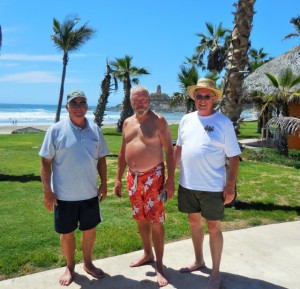
The most dynamic aspect of the economy continues to be tourism, with a number of natural resources which are apt for this purpose, such as the grey whales that come to the area to breed and the natural rock arch at Land’s End is frequently photographed. Tourist attractions are divided into three regions: north (Guerrero Negro to Ciudad Constitución), center (La Paz to Todos Santos) and south (Los Barriles to Cabo San Lucas). There are two main resort areas, Cabo San Lucas and San Juan del Cabo, both in the southern tip of the peninsula. A highway known as the Corridor links the two towns. Other attractions include deep sea fishing, golf, tennis, motorcycling, scuba diving and snorkeling, with windsurfing at Medano Beach and surfing at Todos Santos, Pescadero East Cape and Scorpion Bay. Other important activities include fishing and fish farming, alternative energy production, mineral and salt extraction, film production, information and communication technologies and biotechnology.

Transportation infrastructure
As of 2011, the state has 5,651 km of highway, eleven ports, five of which are international and four international airports. The peninsula’s main transport artery is Mexican Federal Highway 1, which runs from the southern end of the peninsula at Cabo San Lucas to the United States-Mexico border at San Ysidro. Mexican Federal Highway 19 provides an alternate route between Cabo San Lucas and La Paz. There are also ferries from the east coast of the peninsula to the mainland, with most going to Mazatlán in the state of Sinaloa. This trip takes about five hours. The state’s main airports are Los Cabos International Airport and Manuel Márquez de León International Airport.
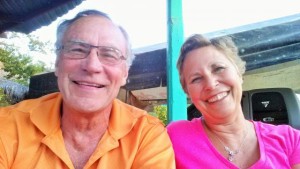
Baja California Sur Fun Facts
• The coat of arms of Baja California Sur emphasizes the region’s connection to the sea. Silver fish against a blue background stand for the ocean and its abundance, while a silver shell recalls the border battle waged by the inhabitants of Baja California Sur. A narrow golden border symbolizes the region’s rich soil, and a wider blue band signifies the virtues of loyalty, justice, and truth. In the center, a gold panel represents wealth and value, while a red panel suggests unity and daring.
• Baja California Sur, bordered by two seas, has the longest coastline of all the Mexican states at more than 2,000 kilometers (1,243 miles).
• Baja California Sur features more islands than any other state. Although most of the islands are located in the Gulf of California, the largest one is Margarita Island, on the Pacific side.
• Todos Santos in Baja California Sur is widely believed to have been the inspiration for the Eagles’ song “Hotel California.”
• The cardón cactus, the world’s largest species of cactus, grows on the Baja California peninsula. It can reach heights of 21 meters (70 feet).
• Every year from mid-December to mid-April, hundreds of gray whales arrive off the coast of Baja California Sur from the Alaska shores. Whale-watchers flock to Guerrero Negro, Laguna San Ignacio and Sierra de Laguna, where they can see whales jumping up to 40 feet in the air.
• Rock shelters in the Sierra de Guadalupe and Sierra de San Francisco feature larger-than life cave paintings of humans and animals.
• Loreto Bay (Nopolo), in Baja California Sur, was the setting for the final episode of season seven of the ABC television show, “The Bachelor.”


